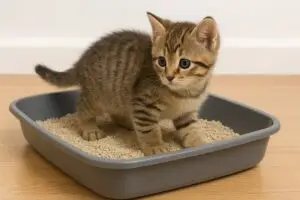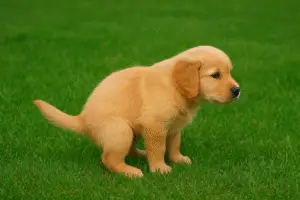Your Ultimate Guide to How to Potty Train a Puppy Fast

Bringing a puppy into your home as a family member is a great joy, but teaching your puppy to potty train at the right time and place is also very important, so that both you and your puppy can enjoy a happy life.
When and Why Puppy Potty Training is Important
You should know what kind of training you should give to your puppy at what age, depending on its age.
A puppy training schedule by age is most important.
The best time to start potty training is when the puppy is 8 to 12 weeks old. At this age, due to their young age, they urinate frequently
(often once every 2-3 hours). Therefore, it is essential to establish a schedule and begin puppy potty training from the very start.
Potty training builds a foundation for your puppy’s behavior, teaches them to establish a daily routine, and helps keep your home clean and odor-free.
Our comprehensive guide will help you succeed in potty training your puppy.
Preparation is key: setting the stage for success :
Before you start potty training, think of it as a mini project. The right tools and mindset will make the whole process easier and smoother.
Choose a specific potty spot
It’s a good idea to designate a specific outdoor spot for your puppy to go potty so that the constant smell will trigger your puppy to go potty.
If you live in an apartment or somewhere without outdoor space, designate a specific spot inside the house and place the pee pad there.
Gather your supplies
- Enzyme cleaner: Simple routine cleaning will not remove the odor, which will only cause your puppy to return to the same accident site. An enzyme cleaner will break down the proteins in feces and urine, eliminating the odor.
- Pee pad: If there are no locations available outside your home or you don’t have time due to work, place puppy pee pads in a specific location inside the house and use them in that designated area.
- Highly value treats: When your puppy potties in the right location, treat him with a very tasty little piece of food. We can call it potty trips.
- Crate or confinement area: Dogs don’t like their living space to be dirty. The crate should be the right size for them to roam around and sleep comfortably. If your puppy is having accidents in the crate, you should provide a crate of the right size.
- Potty bells ( optional ): Hang a bell on the door and ring it when it’s potty time. This will help your puppy get used to the sound of the bell as if it’s potty time.
Step 2: Learn Your Puppy's "I Gotta Go!" Signals
Puppies often show signs that they need a break by doing these activities, and you can take your puppy to the potty spot.
- Circling or sniffing the ground intently
- Whining or barking at you
- Scratching or pacing near the door
- Suddenly stopping play and looking restless
Step 3: Use a Command and Reward Lavishly

This is the foundation of positive reinforcement.
The Command: When your puppy is potty training, you should give them clear, calm commands like “go potty” or “do your business” to help them associate the action with the cue.
The Jackpot Reward: As soon as puppies complete a task, praise them enthusiastically, such as “good boy or girl,” and give high-value treats. Since time is of the essence, rewards should be given immediately after the behavior to create a strong bond.
This teaches your puppy that going to the right place is a good thing!
Step 4: Supervise, Supervise, Supervise
When your puppy is loose in the house, keep a close eye on them. Use a leash tethered to you or baby gates to keep them in the same room. This prevents them from sneaking off to have an accident. If you can’t watch them, they should be in their crate or a safe, puppy-proofed confinement area.
Step 5: Handling Accidents Gracefully (What NOT to Do)
Mistakes will happen. Mistakes are a normal part of learning. What matters is how you handle them correctly.
DON’T: Avoid yelling, nose rubbing, or punishing. Doing so will only teach your puppy to fear you, which can lead to them hiding when they need to go.
DO: If you catch them in the act, calmly demonstrate. And clap your hands and say “oops” and immediately take them to the potty spot. Reward them with praise when they finish the task.
Clean It Up: If an accident occurs anywhere other than the potty, clean it immediately with engine cleaner so that the puppy does not repeat the same accident in the same area.
Common Puppy Potty Training Mistakes to Avoid
Giving Up Too Soon: Potty training requires consistent practice to see progress. Time and patience are very important.
Giving Too Much Freedom Too Soon: Allowing a small dog to roam the house more freely than necessary increases the likelihood of accidents.
Not Using the Crate Correctly: A crate should be like a positive safe house for puppies. Therefore, it is important to provide a crate that is appropriate for the puppy’s age. A crate that is too small can make the puppy feel like they are being punished.
Inconsistent Feeding Times: Since irregular feeding schedules can positively affect potty time, feeding should be done regularly and on the same schedule.
Troubleshooting Common Issues
My puppy was trained, but now they’re having accidents again. This condition is often due to regression or occurs normally between the ages of 6 and 18 months, in which case we need to increase monitoring with a strict schedule.
My puppy won’t signal to go out. Hang a potty bell on the crate and have your puppy ring it gently with his paw. Open the door as soon as he rings the bell. This way, he quickly learns that you open the door when the bell rings, and he will start ringing the bell to let you out before you open the door.
My puppy goes potty outside, but then immediately goes again inside. This means their outing was very short. Wait outside for a few minutes to make sure they are finished.
Conclusion: Patience Leads to a Lifetime of Freedom
Potty training is like a basic skill that builds trusting communication between you and your puppy. It requires an investment of time and patience upfront, but the reward—a dog who reliably knows where to go—is worth every effort.
Celebrate the small victories, stay consistent with the plan, and remember that this challenging phase is temporary. Soon, you’ll have a confident, house-trained companion for life.
Pro Tip: The key to successful training isn’t just punishing mistakes; it’s about proactively creating opportunities for your puppy to succeed and rewarding them heavily for it. Happy training






3 thoughts on “Puppy Potty Training: A Step-by-Step Guide for a Happy, Accident-Free Home”
Pingback: How to crate train a puppy fast at night without crying
Pingback: Kitten Litter Training: A Step-by-Step Guide for New Cat Parents - petopiaguide
Pingback: Essential Puppy Training Schedule by ge for Every Age